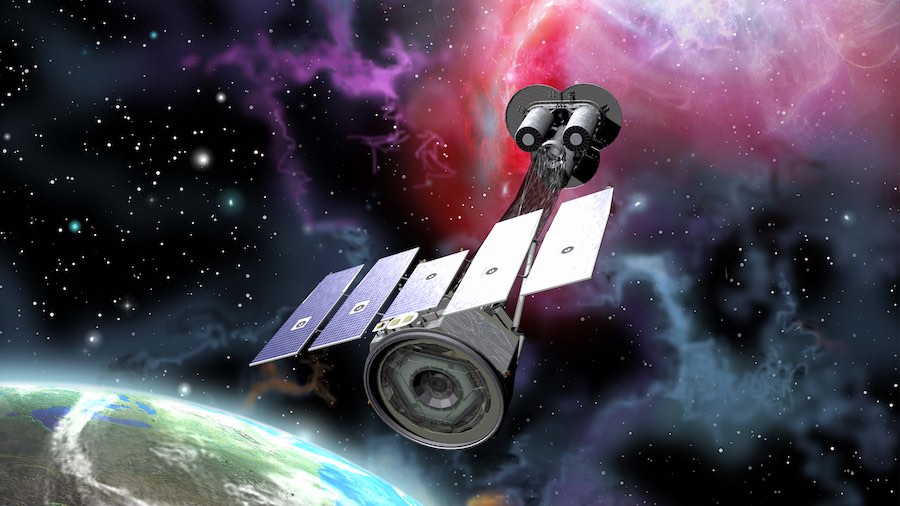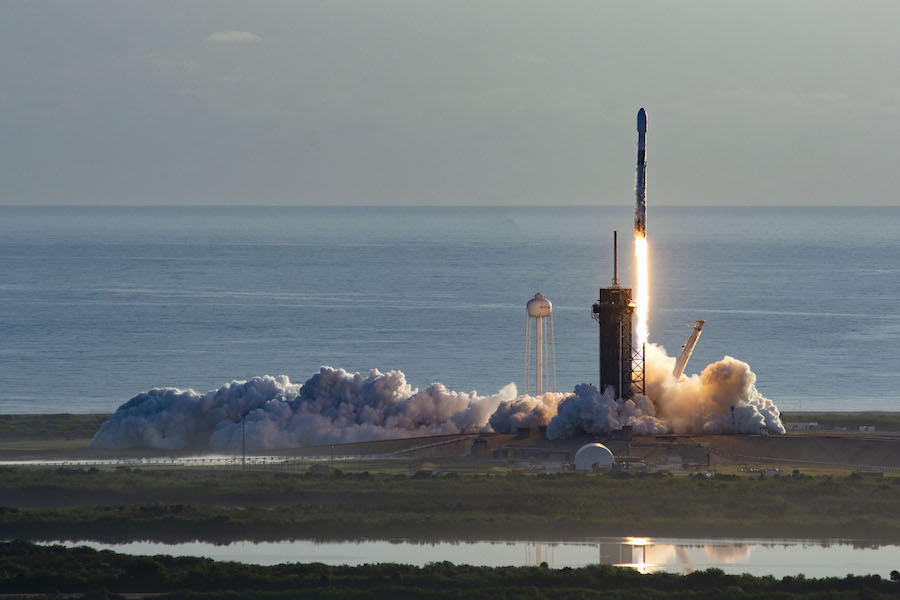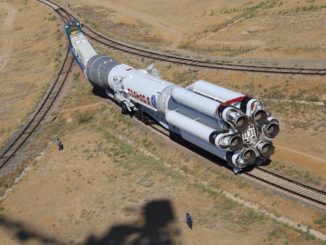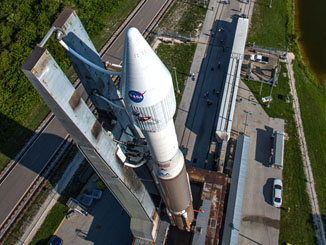
A nearly three-month stoppage of on-site work due to concerns about the spread of the coronavirus at NASA’s Marshall Space Fight Center in Alabama is expected to push back the launch of the IXPE X-ray astronomy satellite from May 2021 until some time later next year, a senior space agency official said.
The Imaging X-ray Polarimetry Explorer, or IXPE, mission is assigned to launch on a SpaceX Falcon 9 rocket from NASA’s Kennedy Space Center in Florida. IXPE is designed to measure the polarization of high-energy cosmic X-rays, collecting data that will allow astronomers to study the unseen environment around black holes, neutron stars and pulsars, the extremely dense collapsed remains left behind by exploding stars.
Astronomers hope IXPE will reveal the spin of black holes, and yield new discoveries about the extreme magnetic fields around a special type of neutron star called magnetars.
In order to obtain the sensitivity required for the X-ray research, the IXPE observatory will host three identical X-ray telescopes that will be extended after launch on a 13-foot (4-meter) boom. Built at Marshall Space Flight Center, the mirror module assemblies at the end of the boom will focus X-rays onto detectors provided by ASI, the Italian space agency.
Paul Hertz, head of NASA’s astrophysics division, said June 23 that work on assembling the mirrors at Marshall was delayed after the space center in Huntsville, Alabama, was closed to all non-essential personnel in March amid escalating numbers of coronavirus cases in the area.
After developing new safety protocols, teams resume in-person work on the mirrors in late May, Hertz said in a presentation to NASA’s Astrophysics Advisory Committee.
Hertz said IXPE was “probably the most seriously impacted” by the coronavirus pandemic of all of NASA’s Explorer-class missions, a set of small-to-medium size scientific spacecraft designed to pursue questions in astrophysics and solar physics.
“The reason is COVID hit right when we were integrating the mirrors down at the Marshall Space Flight Center, and that is the critical path,” Hertz said. “So when Marshall shut down for three months, nothing happened on the critical path for three months.”
Some work on IXPE has continued, Hertz said.
Ball Aerospace in Boulder, Colorado, kept working on the IXPE spacecraft bus, which will host the X-ray mirrors and detectors. And Italian scientists providing the mission’s X-ray detectors finished their work and prepared them for shipment to the United States, once international travel restrictions allow Italian team members to accompany the hardware to help integrate it into the spacecraft.
“The collective safety of our IXPE team continues to be the number one priority,” said Molly Porter, a NASA spokesperson. “We’re slowly and methodically resuming mission-critical work that cannot be done off site. This includes several tasks for the in-house production of IXPE’s mirror modules at NASA’s Marshall Space Flight Center.
“We are still assessing COVID-19’s impacts to cost and schedule,” Porter said.
The team at Marshall will assemble, calibrate and test the mirrors before shipping the flight units to Ball Aerospace for integration on the spacecraft, Hertz said.
NASA also anticipates a budget impact to the IXPE mission from the delay.
“So IXPE did have a three-month delay,” Hertz said. “This happened right at the peak burn rate for IXPE, and we would have completed work and rolled staff off, but the work didn’t complete, so we didn’t roll staff. So not only was it a schedule hit, it was also a budget hit.”
NASA selected IXPE to become the next in the agency’s line of Small Explorer missions in January 2017. At the time, NASA said the IXPE mission would cost $188 million, covering development of the spacecraft and its X-ray telescope payload, a launch vehicle, and two years of operations.
NASA last year signed a $50.3 million contract with SpaceX to launch the IXPE satellite on a previously-flown Falcon 9 booster from the Kennedy Space Center. According to Porter, IXPE is currently predicted to weigh around 743 pounds (337 kilograms) at launch, and will deploy off the Falcon 9 rocket into an unusual 335-mile-high (540-kilometer) equatorial orbit with an inclination of 0.2 degrees.
The orbit hugging the equator will minimize the X-ray instrument’s exposure to radiation in the South Atlantic Anomaly, the region where the inner Van Allen radiation belt comes closest to Earth’s surface.
“I think that certainly IXPE was the most impacted (of NASA’s Explorer missions) because of the timing of when work stopped,” Hertz said. “They were at the worst time for us to stop work of all of our small missions.”

NASA’s other Explorer-class missions being prepared for launch have experienced fewer impacts from the COVID-19 pandemic.
GUSTO, a high-altitude balloon-borne infrared telescope to study the interstellar medium, remains on track for launch from Antarctica in December 2021. NASA’s SPHEREx satellite is scheduled for launch in 2024 on a mission to survey galaxies and search for clues about the formation of ices that could seed life on planets.
Hertz said two major subcontractors working on the SPHEREx mission could not start work on schedule due to the coronavirus pandemic. That caused some delays, but the SPHEREx mission is still relatively early in development, not in the peak phase of assembly and testing like IXPE.
It is too early to know how the coronavirus-related delays might affect NASA’s budget for astrophysics missions, Hertz said.
“We don’t actually know what the final impact will be because we don’t know what the trajectory is for the country and all of our industry partners and academic partners for recovering from the pandemic and getting back to work,” Hertz said. “So for some missions, it’s easy to see like IXPE because there’s a single path right now as we’re integrating it up.
“For the Explorers, we’ll be able to handle the impacts within the resources that I think we have within the program,” he said.
Hertz said he believes NASA’s budget for the James Webb Space Telescope, which has cost more to develop than any space science mission in history, also has “adequate” funding reserves “to encompass all possible predictions of what the COVID impact is.”
“I hope that doesn’t come back to bite me, but right now it does look like we have in place appropriate reserves on Webb,” Hertz said.
NASA established a new budget for Webb in 2018 that covered an expected development cost of $8.8 billion. That does not include international contributions or operating costs after the observatory’s launch.
Like IXPE, Webb experienced a slowdown in work due to the coronavirus. Teams worked at about 40 percent efficiency for several months, but starting staffing at higher levels in June to prepare for a series of key ground tests later this year.
Webb’s launch is expected to be delayed from its previous target of March 30, 2021, but NASA has not yet released an updated schedule.
More than half of the this year’s budget for NASA’s astrophysics program goes toward the James Webb Space Telescope and the Nancy Grace Roman Space Telescope, formerly known as WFIRST. Those are NASA’s next two “great observatories.”
The Roman telescope is scheduled for launch in 2025.
“On Roman, I’m just unsure of what the impact (from COVID-19) will be because Roman is doing fine today, but there’s some work that’s not getting done today, so it’s being deferred into the future,” Hertz said. “But that work is funded. So whether we’re just redistributing the work and the money, and it’s not really a cost growth, or whether there’s inefficiencies that amount to something substantial on Roman, I think it’s too early for us to tell.”
Email the author.
Follow Stephen Clark on Twitter: @StephenClark1.



